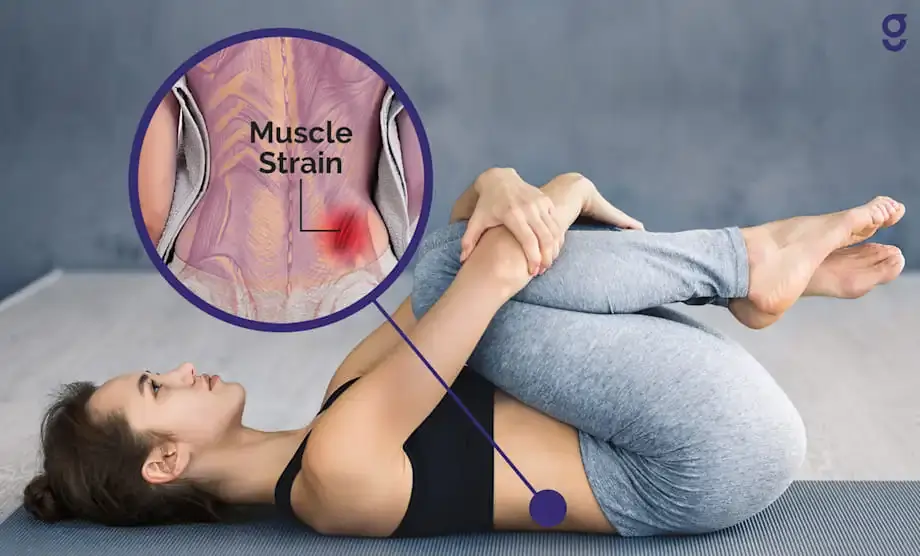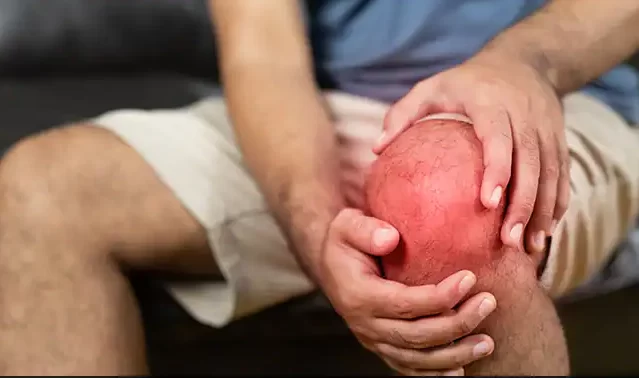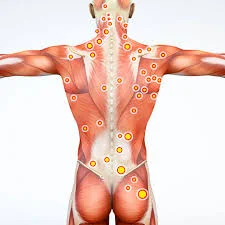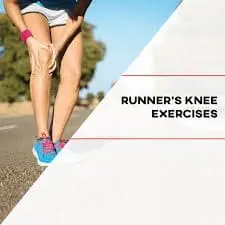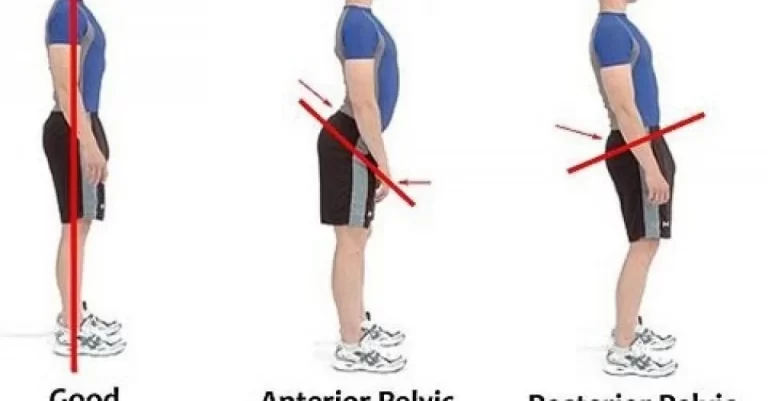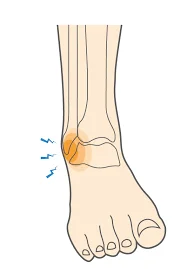14 Best Exercises For Lumbar Strain
Introduction:
Your spine’s lower portion, or the five vertebrae designated L1 through L5, is referred to as the lumbar region. In most cases, lumbar strains damage the surrounding ligaments, tendons, or muscles.
Depending on how serious the damage is, the pain could be minimal or severe. Pain, stiffness, loss of mobility, swelling, trouble walking or bending, and muscular spasms are all signs of back strain. After the injury, you can resume light exercise once the initial pain goes away, generally within two to five days.
Always get advice from your physician or physical therapist before beginning any back injury workout regimen. They can accurately diagnose you, identify more serious diseases, and provide a safe and effective plan tailored to your needs.
When you first begin, do each exercise many times. As you become more comfortable with an exercise, you can then increase the frequency of your workouts.
Causes:
Unexpected Motions or Lifting
- Incorrect lifting method.
- Lifting an unusually sized or heavy object.
Core Muscle Weakness
- The strain on the lumbar spine is increased when the muscles of the abdomen and spine are not supported.
- Raises the risk of lower back muscular damage and overuse.
Suddenly Increasing Physical Activity
- Beginning a new sport or workout without a proper warm-up or conditioning.
- Starting vigorous exercise right after a time of inactivity.
Accidents or Trauma
- Back muscles can be overstretched or jolted by falls, sports injuries, or auto accidents.
- Direct impact on the lower back.
Changes Associated with Age
- As people age, their muscle endurance and mobility naturally decrease.
- Stress from little situations is more likely to affect older persons.
Uncomfortable Posture
- Prolonged sitting, particularly when the back is not well supported.
- Leaning forward or bending over are examples of postures that are out of balance when standing or walking.
- Postures that put tension on the lower back when you sleep.
Being overweight
- Stress on the lumbar spine is increased by excess body weight.
- May change one’s walk and posture, making one more subject to strain.
Tension in the muscles and stress
- Unconsciously tightening of the back muscles might result from emotional tension.
- Strain or pain might eventually result from ongoing stress.
Improper Footwear
- Posture and spinal position can be impacted by a lack of support, such as worn-out or flat shoes.
- Increases the lower back’s strain with time.
Repetitive stress or overuse
- Prolonged hard lifting, bending, or twisting.
- Jobs or sports that require a lot of movement or manual effort.
- Workplace ergonomics is poor.
Signs and symptoms:
Located Pain in the Low Back
- The lower back (lumbar spine) is the primary location of pain, usually across the belt line or out to one side.
- Since it doesn’t typically go down the legs, it is non-radiating.
- Depending on its intensity, it might seem like a searing pain, excruciating pain, or a dull, uncomfortable feeling.
Reduced Range of Motion and Stiffness
- Trying to stand up straight, bend forward, or rotate.
- Particularly after rest, movements may seem constrained.
- To prevent causing pain, some people “walk stiff” or move slowly.
Spasms in the muscles
- Involuntary back muscular contraction or tightness.
- It can limit movement and cause stiffness.
- May feel like tight bands or hard “knots” in the muscles.
Sensitivity to Touch
- By applying pressure or feeling affected muscles, pain can be generated.
- The skin surrounding the region might feel sensitive at times.
Changes in Posture
- People may hunch forward, lean to one side, or refrain from standing upright to lessen pain.
Pain Reduction Through Sleep
- Usually, resting or avoiding activities that worsen the pain helps.
- Temporary comfort is frequently obtained by resting on a solid surface.
Pain That Gets Worse When You Move
- The following causes more pain: Bending, twisting, and lifting.
- Extended periods of sitting or standing; sudden motions, such as coughing, sneezing, or getting out of bed
Exercise’s advantages:
Speeds up the Healing Process
- Blood flow to the wounded region is increased by gentle, controlled movement.
- Oxygen and nutrients are provided for tissue repair by increased blood flow.
- Prevents muscle or tendon fibers small tears from becoming rigid and encourages their recovery.
Prevents Recurrence
- An effective workout program targets the underlying problem, such as weak core muscles or insufficient mobility.
- Lowers the chance of repetitive strain from sports or daily activities.
Improves Mental Health
- Since stress, worry, and depression have been shown to increase muscular tension, physical activity helps to lessen them.
- Improves mood and the quality of sleep, both of which promote recovery.
Enhances Back and Core Muscle Strength
- More tension on the lumbar muscles results from weak core muscles.
- Load shifts by strengthening the glutes, obliques, abdominals, and spinal stabilizers.
- Increased strength lessens the likelihood of strain recurrence and supports the spine.
Lessens Muscle Spasms and Pain
- Muscle spasms and stiffness are lessened by stretching exercises.
- The buildup of inflammatory substances that cause pain is reduced by movement.
- Makes the body’s natural pain-relieving systems work.
Restores range of motion
- Encourages hamstring, hip, and spine movement and flexibility.
- Avoids joint contractures or chronic stiffness.
- Makes it possible to resume regular daily activities more quickly.
Improves body mechanics and posture.
- Helps in resolving bad posture or movement patterns that cause the tension.
- Promotes safer sitting, lifting, and bending techniques.
- Lessens excessive strain on the lumbar area and promotes proper spinal positioning.
Exercises For Lumbar Strain:
Your back can heal with exercise. Additionally, it makes your back stronger and more flexible, which helps you avoid getting hurt again.
Pelvic Tilts
- Start with the supine position on the floor.
- Ensure that your feet are level with the floor.
- Next, band your knees.
- Stretch your arms around your body with your palms facing down.
- Provide space between your lower back and the mat so that your back can continue to curve naturally.
- Your hand should be able to slide into this area.
- Take a breath.
- Then, when you exhale, tighten your abdominal muscles.
- Your lower back will feel a light stretch.
- Hold this position for a few seconds.
- Then return to your neutral position.
- Then relax.
- Repeat these exercises five to ten times.
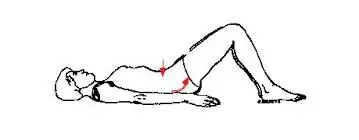
Cat-Cow Stretch
- Start by assuming a table posture on your hands and knees with your spine neutral.
- Take a breath and go into cow stance by pushing your chest forward, raising your sit bones higher, and contracting your abdominal muscles.
- Raise your head and gaze directly ahead.
- Hold this position for a few seconds.
- As you exhale, lift your pubic bone forward and lengthen your spine outward for cat pose.
- Allow your head to fall to the ground rather than pulling your chin to your chest.
- Hold this position for a few seconds.
- Then return to your neutral position.
- Then relax.
- Repeat these exercises five to ten times.
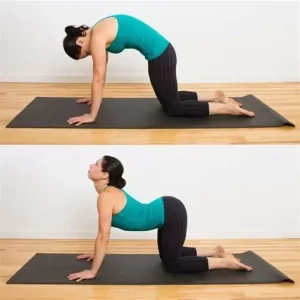
Knee-to-Chest Stretch
- Place your feet flat on the floor and begin by reclining on your back.
- Position your hand behind your knee or just behind your kneecap.
- Lift your knee to your chest now.
- Hold this position for a few seconds.
- After that, release your leg.
- Then return to your neutral position.
- Then relax.
- Repeat these exercises five to ten times.
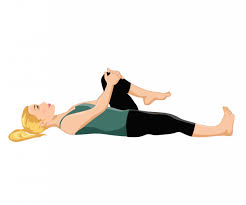
Bridges
- Begin by assuming a comfortable position on the bed.
- After that, bend your knees.
- Next, tighten the muscles in your abdomen.
- Raise your upper body.
- Please keep your arms by your sides.
- Hold this position for a few seconds.
- Drop your body.
- Then return to your neutral position.
- Then relax.
- Repeat these exercises five to ten times.
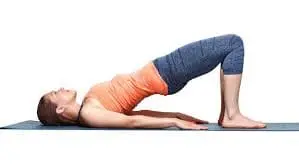
Child’s pose
- Start by positioning yourself like a tabletop on the floor.
- Place your big toes together and comfortably spread your knees apart.
- Gently lean your hips back towards your heels.
- Raise your arms and position them in front of you, palms down.
- Put your forehead down on the ground.
- Deeply inhale into your sides and lower back.
- Hold this position for a few seconds.
- Then return to your neutral position.
- Then relax.
- Repeat these exercises five to ten times.
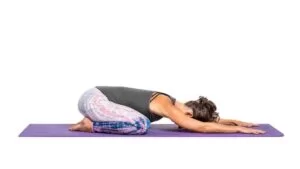
Wall Hamstring Stretch
- Look for an open doorway.
- Position yourself lying on the ground or a mat with your left leg fully extended on the floor and your back flat.
- The doorway should be passed by the left leg.
- Place the right leg on the doorway’s nearby wall.
- Adjust the distance between the body and the wall to achieve mild tension in the right leg.
- Hold this position for a few seconds.
- Then return to your neutral position.
- Then relax.
- Repeat these exercises five to ten times.
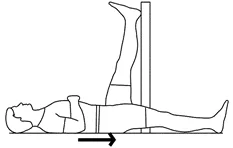
Lying Hamstring Stretch
- Lay down on the floor to begin.
- Put the heel of one leg on a towel, belt, or strap as you raise it.
- Take hold of the strap with both hands.
- Slowly pull your leg in your direction.
- Your lower back should remain neutral, and your knee should stay straight.
- Hold this position for a few seconds.
- Flex your foot to maximise the stretch and prevent the knee from being overstressed.
- Then return to your neutral position.
- Then relax.
- Repeat these exercises five to ten times.
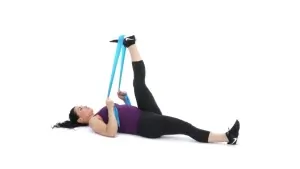
Bird Dog
- Sitting on a tabletop, begin by calming down on all fours.
- Maintain a neutral posture for your spine.
- Squeeze in between your shoulder blades.
- Then raise your right arm and left leg as high as you can.
- Keep your shoulders and hips parallel.
- Hold this position for a few seconds.
- Then return to your neutral position.
- Then relax.
- Repeat these exercises five to ten times.
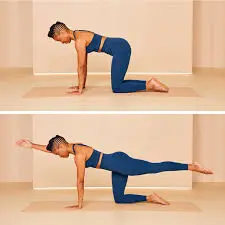
Core marching
- With your feet level on the floor or raised to a tabletop posture, and your knees bent at a 90-degree angle, lie on your back.
- Pull your belly button toward the floor and press your lower back into the floor to activate your core.
- With the opposing leg and pelvis remaining constant, raise one foot a few inches off the ground.
- Carefully drop the foot, then repeat the movement with the opposite leg.
- Then return to your neutral position.
- Then relax.
- Repeat these exercises five to ten times.
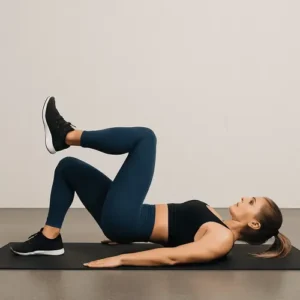
Lower back stretch
- Start in a lying down position on the floor.
- Then flex both knees.
- Raise your legs to your chest while holding them together with both hands.
- Pull your knees carefully towards your chest while keeping your lower back relaxed on the floor.
- Remain calm and concentrate on taking deep breaths.
- Hold this position for a few seconds.
- Then return to your neutral position.
- Then relax.
- Repeat these exercises five to ten times.
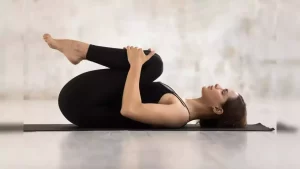
Wall sit
- Get started by standing on the floor.
- Maintain a hip-width distance between your feet and a forward-pointing toe.
- Let your back glide down the wall while bending your knees.
- Sitting down more deeply requires a couple of steps, but be careful that your knees do not extend past your toes.
- Hold your position for a few seconds.
- You should feel your weight in your heels rather than your toes.
- Then return to your neutral position.
- Then relax.
- Repeat these exercises five to ten times.
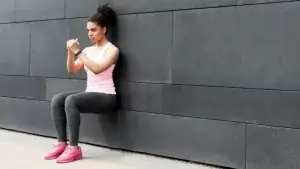
Plank
- Place your forearms directly behind your shoulders while lying on the floor.
- Press onto your knees and forearms to slowly raise your entire body off the ground.
- As you rise, keep your neck and spine neutral and contract your core.
- Make sure your body is in a straight line by lifting your knees and tucking your toes beneath.
- Hold this position for a few seconds.
- Then return to your neutral position.
- Then relax.
- Repeat these exercises five to ten times.
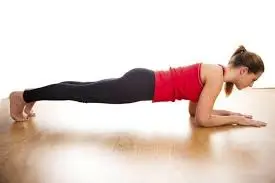
Hip flexor stretch
- Get started by standing on the floor.
- At this point, bend your leg to a 90-degree angle and jump forward.
- If necessary, you can support your hands by placing them on your front knee.
- Keep the upper body upright.
- Then, push your body forward until it feels pressed.
- Hold this position for a few seconds.
- Then return to your neutral position.
- Then relax.
- Repeat these exercises five to ten times.
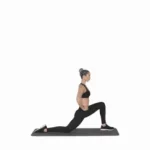
Supine twist
- Begin by lying on your back on the floor.
- Put your arms sides.
- The right foot should be placed on the left knee while the right knee is bent.
- Let go of the breath.
- Rotate your lower spine and back as you drop your right leg to the left side of your body.
- Keep your shoulders level on the floor, close your eyes, and ease yourself into the pose.
- You can do this effortlessly if you let the knee drop naturally.
- Breathe deeply, then hold the position for a few seconds, letting your spine slowly rotate.
- Then return to your neutral position.
- Then relax.
- Repeat these exercises five to ten times.
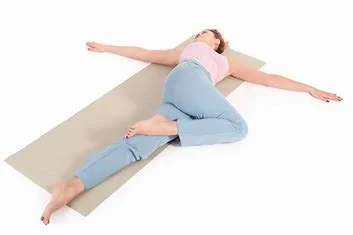
What safety measures must be taken when exercising?
Get started with a warm-up.
- Always begin with energetic, moderate motions.
- This lessens the chance of making the tension worse by warming the muscles, increasing blood flow, and reducing stiffness.
Make Slow Progress
- Begin with low-impact, low-intensity activities and work your way up to more challenging ones.
Make Use of Proper Form and Technique
- Poor form might lead to further injuries or worsen a lumbar strain.
- Holding your breath causes your intra-abdominal pressure to rise.
- If necessary, use mirrors or supervision to keep an eye on posture.
After working out, relax.
- Muscle relaxation and stiffness can be avoided by gentle stretching and regulated breathing.
- Don’t quit suddenly without doing any recovery exercises.
Avoid Extended Bed Rest
- Resting too much weakens muscles and slows the healing process.
- Walking and light movement, even in the early stages, are advantageous than prolonged immobility.
If assistance is required, use it.
- A hard, not a soft, workout mat for support.
- To lessen the strain on the spine during specific movements, use a cushion, a towel roll, or lumbar support.
Maintain Proper Hydration and Breathing
- Dehydration may cause tiredness or cramping in the muscles.
- Deep breathing reduces stress and guarantees that oxygen reaches healing tissues.
When did you stop working out?
Pain that is intense or radiating
Stop right away if you experience:
- Pain that is immediate, sharp, or stabbing
- Burning, tingling, or numb feelings
- Not only a muscular strain, but nerve involvement may be indicated by these symptoms.
Cramping or Spasming Muscles
- Stop exercising if your lower back suddenly starts to cramp or spasm.
- This might indicate that your muscles are strained or unprepared for such a high degree of activity.
Unable to Maintain the Correct Form
Put an end to it if you:
- Go off balance
- Start compensating using other body parts, such as the hips and shoulders.
- Unable to activate your core or maintain a neutral spine
- Maintaining bad form could worsen the tension or result in further damage.
Unusual or New Symptoms
- Stop working out and get medical attention if you suffer from:
- Loss of control over the bowels or bladder
- Leg weakness that comes on suddenly
- Night sweats, weight loss, or fever (which may indicate an infection or other systemic problems)
Increased Pain During or Following Physical Activity
- Mild pain during rehabilitation activities is common.
- If Pain worsens while moving, stop the exercise or modify it.
- Pain persists for more than one to two hours following activity and doesn’t go away with time.
Indications of Tiredness
- Being tired raises your chance of getting hurt.
- Stop and take a break if your muscles are shaking or you feel weak, or dizzy.
- Additionally, excessive weariness impairs bodily control and coordination.
Which exercises should you stay away from when you have lumbar muscle strain?
It’s important to stay away from workouts and actions that put more tension on the lower back or delay recovery when recovering from a lumbar muscle strain.
Conventional Crunches and Sit-Ups
- The lumbar spine may be pulled by them as they work the hip flexors.
- Put more stress on the lower back’s muscles and discs.
- Frequently done incorrectly, which worsens the problem.
Touching the toes when standing or sitting
- Bending forward too much strains the lumbar muscles that are already damaged.
- It can result in episodes by increasing pressure on the spinal discs.
Deadlifts, particularly heavy ones
- Deadlifts put a lot of strain on the lumbar region, even when done correctly.
- When recovering, there is a significant chance of poor form or compensation.
- Can, if done incorrectly, exacerbate muscular tension or result in herniation.
Jumping and running
- High-impact exercises force the spine to move repeatedly.
- Might worsen the strain or postpone recovery.
- If the glutes and core are not yet strong enough to support the spine, Running often makes pain worse.
Lifting the Legs
- The hip flexors, which connect to the lumbar spine, are activated by this action.
- The damaged lower back may experience excessive strain as a result.
Lunges or heavy squats (especially with weights)
- May cause lumbar spine strain if performed incorrectly or without enough core control.
- Squats that bend forward provide a particular risk to the lower back.
Superman Exercise for Back Extensions
- When lying prone, raising both arms and legs off the ground results in hyperextension of the spine.
- Puts too much pressure on the lower back, especially when the patient is just starting to recover.
High-Impact Cardio (plyometrics, burpees, and HIIT)
- Strong core stability is necessary for explosive motions, although recovery may weaken this stability.
- Jumping and sudden direction changes can strain recovering tissues.
Poorly Forming Overhead Presses
- The lower back might get overextended while lifting weights overhead without engaging the core properly.
- Increases the spine’s compressive strain when the muscles aren’t prepared.
Twisting motions (golf swings, Russian twists)
- Waist rotation might put too much strain on the lumbar muscles and ligaments that are recovering.
- Particularly dangerous in the early stages when the spine is irritated or painful.
Advice on how to prevent lumbar muscle strain:
Protecting your lower back with proper posture, intelligent movement, core strength, and lifestyle choices is essential for preventing lumbar muscle strain.
Develop Core Strength
- Your spine is stabilized by your core muscles.
- Having a strong core reduces the stress on the lumbar muscles and contributes to absorbing force while lifting, twisting, or hitting.
Before beginning an activity, warm up
- Before engaging in intense physical activity or exercise, always perform dynamic stretches and moderate aerobic exercises for 5 to 10 minutes.
Keep Your Posture Correct
- When sitting, maintain a neutral spine, flat feet, and hip-level knees.
- If necessary, use lumbar support.
- When standing, equally divide your weight between your two feet.
- Avoid arching your back or leaning to one side.
- In every lifting exercise, use your legs rather than your back.
Stretch Frequently
- An increased risk of strain can result from tight hamstrings, hip flexors, and glutes pulling on the pelvis and lower back.
- Stretching gently every day maintains the mobility of muscles and connective tissue.
Keep yourself hydrated and nourished.
- Dehydrated muscles are more likely to strain and spasm.
- For tissue strength and healing, make sure your diet has enough calcium, magnesium, vitamin D, and protein.
Utilize Safe Lifting Methods
- Approach the item, maintain a straight back, and use your legs to raise it.
- When lifting, rotate with your feet rather than your spine to avoid twisting.
- Maintain load balance and use both hands.
Avoid Excessive Training or Unexpected Increases in Activity
- Increase the length of your workouts and the level of difficulty gradually.
- One of the main causes of lumbar strain is overexertion, particularly following periods of rest.
Control Your Stress
- Muscle tightness is made worse by stress, particularly in the shoulders and lower back.
- To relieve tension, think about stretching, mindfulness, or breathing techniques.
Pay Attention to Your Body
- Early warning indications of back pain, such as tightness, soreness, and fatigue, are indicators to rest or adjust activities. Please don’t ignore them.
- Act now to prevent it from developing into a serious strain.
Summary:
One of the most frequent causes of back pain is lumbar strain, which happens when the lower back’s muscles or tendons are overextended or damaged. Heavy lifting, bad posture, sudden movements, or even extended sitting might cause this problem. In the early stages, rest and pain management are crucial, but mild workouts can greatly speed up healing, increase range of motion, and help avoid further injuries.
By performing certain stretches and exercises, you can reduce back pain and improve the flexibility of the affected muscles. Exercise improves physical performance by strengthening the core. Back muscular tightness can be lessened, tension can be released, and flexibility can be increased with exercise. Exercises that strengthen the glutes help in posture and provide back support during standing, sitting, and walking.
The proper motions can improve mobility, lessen pain, and stop further injuries with regularity and caution. Take it gently at first, pay attention to your body, and consider getting personalized guidance from a physical therapist.
FAQ:
What does a lumbar strain mean?
Lower back injuries that directly impact the muscles and tendons supporting the spine are known as lumbar strains. Stretching or tearing these tissues can result in pain, stiffness, and even muscular spasms. The injury often comes on with rapid movements, excessive use, or incorrect lifting methods.
What is the duration of recovery for a lumbar strain?
The majority of back muscle strains heal in three to four weeks, although many just need a few days. Most people who suffer from minor to serious lumbar strains recover completely and are symptom-free in a matter of days, weeks, or even months.
Can lumbar strain be alleviated by walking?
Walking is a low-impact activity that increases flexibility, strengthens core muscles, and improves circulation, all of which can help relieve pain in the back. Take short, moderate walks at first, then as your back gets stronger and more flexible, progressively increase the distance and effort.
Should a lumbar strain be stretched?
As they restrict the spine’s natural movements, stiff back muscles place additional load on the vertebrae. Because they restrict the spine’s natural movements, stiff back muscles increase the strain on the vertebrae.
How should a lumbar strain be treated?
Avoid sleeping on your stomach.
Don’t twist your back or lift heavy objects.
Avoid stooping or bending repeatedly.
Stay away from prolonged sitting.
When I have a lumbar strain, how should I sleep?
Given that it relieves the strain on the spine, sleeping in a lying down position can greatly minimize lower back pain. Important equipment for achieving this position includes specifically made cushions or beds that can be adjusted.
If I have a lumbar strain, can I still work out?
Continue to move, but use caution, if your back pain is not too severe. Exercise helps the relaxation of your muscles and encourages the healing flow of blood to the injured area. However, there is a thin line between exercising too much or incorrectly, as this might worsen the pain.
What can I do to strengthen my lumbar region?
Exercises that include pelvic tilt stabilize and strengthen the muscles in the lower back and abdomen. An active workout that moves the spine only using the abdominal muscles in a single position. Place your feet flat on the floor and bend your knees as if lying on your back. Push the lower back to the floor and tighten the muscles in your stomach.
Which workout forms are the greatest to begin with?
Pelvic tilts
Knee-to-chest stretches
Cat-cow movements
Bird-dog
Walking
Can lumbar strains be avoided in the future with exercise?
Indeed. Future back issues can be considerably decreased with a planned exercise program that incorporates mobility exercises, posture training, and core strengthening.
Do lumbar strain exercises require a physical therapist?
Although it’s not always necessary, seeing a physical therapist is strongly advised, particularly if:
Pain persists for more than two weeks.
You’ve experienced several stresses.
You’re uncertain about the form or the safety of the workout.
You are going back to playing sports or doing laborious tasks.
References:
- Spend fifteen minutes a day doing back exercises. (undated). The Mayo Clinic. Back pain in detail: https://www.mayoclinic.org/healthy-lifestyle/adult-health/art-20546859
- Experts propose five exercises for low back (muscle) strain. (undated). https://www.goodpath.com/learn/back-strain exercises
- Cronkleton, E. May 20, 2024. 7. Stretches for the lower back can help reduce difficulty and improve range of motion. https://www.healthline.com/health/lower-back-stretches Healthline.
- Fornari, E., Schulz, J., Gomez, J., & Moloney, C. (n.d.). Montefiore Paediatric Orthopaedic and Scoliosis Centre, Children’s Hospital at Montefiore. Minimal strain on the back. Paediatric Expertise/Orthopedics/Monte: https://www.cham.org/File%20Library/Global%20Navigation/Expertise%20And%20Programs -EXERCISES AT LOW BACK STRAIN.pdf
- K. Hamilton, MD. (September 8, 2017). Lower back muscle strain exercises. Spinal health. Exercises for Lower Back Muscle Strain https://www.spine-health.com/conditions/lower-back-pain
- Strain on the lower back. May 10, 2025. WebMD. Low back strain https://www.webmd.com/back-pain
- On August 26, 2019, the Comprehensive Spine Institute released this statement. Ten Back Injury Recovery Exercises You Should Do. The Comprehensive Spine Institute. Here are some exercises you should do to recover from a BA: https://www.csiortho.com/blog/2018/July/10
- Image 9, Supine marches: advantages, advice, and workout guide Vitruve, n.d. Exercises/supine-marches-exercise-guide-tips-and-benefits/ Vitruve. https://vitruve.fit/

